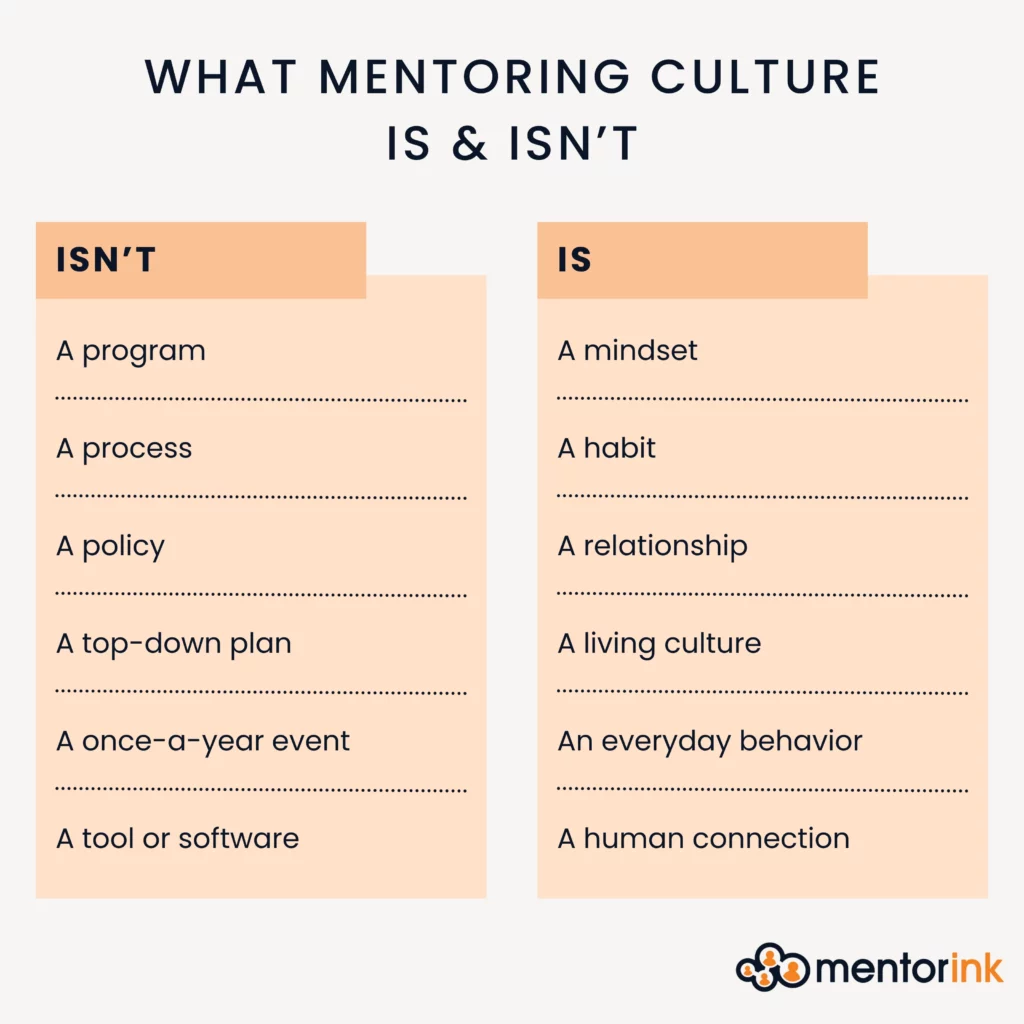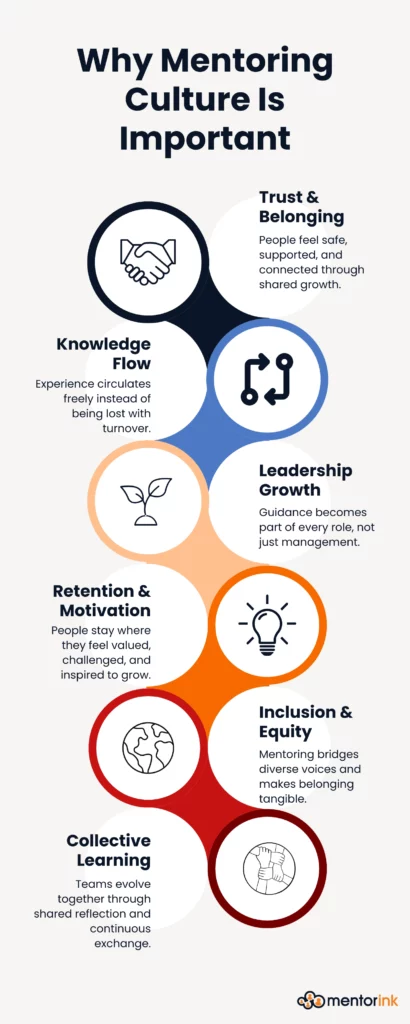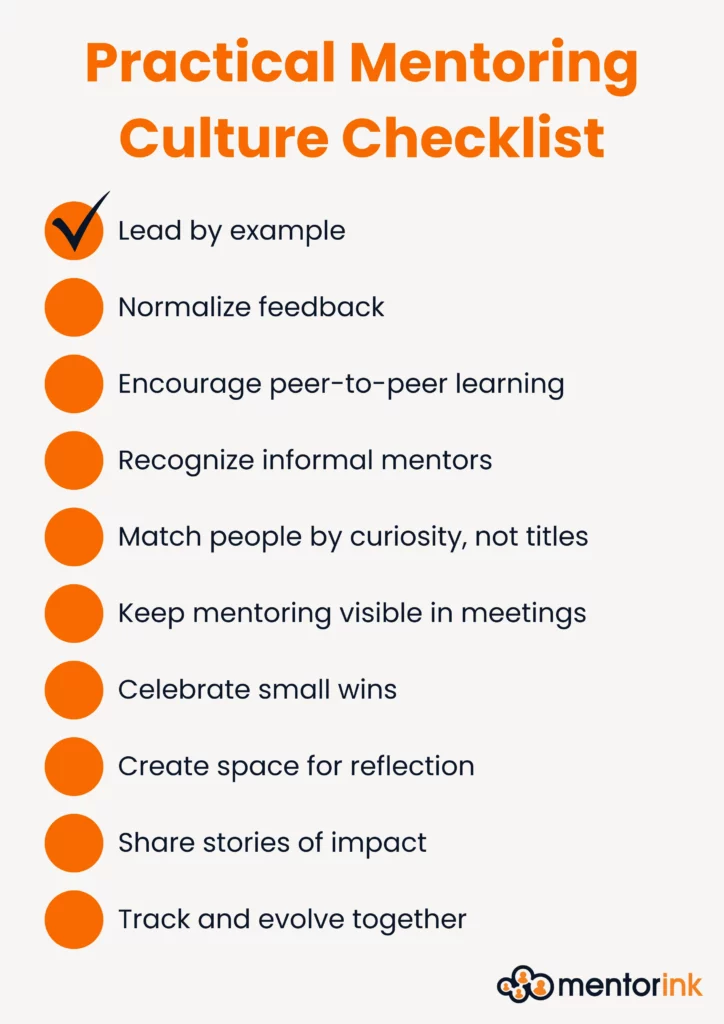
Think of every moment someone in your organization paused to listen, guide, or share a story from experience. Those quiet exchanges rarely appear in reports, yet they shape how people learn, lead, and feel part of something bigger. That’s what a mentoring culture is built on.
It’s more than scheduled sessions or formal programs; it’s the everyday rhythm of asking, helping, and growing together.
When guidance becomes part of how people naturally connect, mentoring stops being an initiative and starts becoming culture, a shared practice of learning and development that begins with understanding what mentoring truly is, as explored in our What Is Mentoring? article.
This article explores how that transformation happens and why it matters for every organization that wants to build engagement, retention, and trust through mentoring.
What Mentoring Culture Is and Isn’t
You might ask what a mentoring culture really means. Before answering that, let’s first look at what it isn’t. A mentorship culture isn’t a campaign or a project plan. It’s not about assigning pairs once a year or tracking participation in a spreadsheet. It’s about how people show up for each other, every day.
A mentoring culture isn’t:
- a one-time program launched by HR or L&D
- limited to formal mentor–mentee pairs
- dependent on software, templates, or deadlines
- a top-down initiative driven only by leadership
A mentoring culture is:
- a shared mindset of curiosity, empathy, and growth
- everyday habits of asking, listening, and sharing experience
- leaders and peers modelling guidance through example
- trust that allows people to learn openly and give freely
- a living system that sustains itself through connection, not control
When mentoring becomes culture, it’s no longer an activity to organize but a way people naturally learn, support, and evolve together.

Understanding what mentoring culture looks like is only half the story; what truly defines it is the difference it makes. The next step is understanding why it matters, and how its impact reaches far beyond individual growth.
Why Mentoring Culture Is Important
A mentorship culture matters because it changes how people relate, not just how they perform. It turns growth into a shared process that connects experience, purpose, and care.
In environments where mentorship thrives, knowledge moves freely instead of being guarded. People exchange lessons, stories, and insights that keep learning alive across generations. This creates a foundation of trust, empathy, and belonging, the quiet strengths behind every resilient organization and community.
Mentoring culture also transforms leadership. Guidance is no longer tied to titles or tenure; it becomes a shared responsibility. People learn to listen, give feedback, and help others grow, shaping collaboration and confidence across every level.
Above all, mentorship culture sustains itself through meaning. People stay engaged not because they must, but because they feel part of something larger than their own goals. That shared sense of purpose turns individual development into collective continuity, and work into community.
Once you know what mentorship culture really means, the next question is simple: what difference does it make?

Benefits of a Mentoring Culture
A strong mentoring culture turns growth into part of daily life, where learning moves naturally through connection, not structure. Here’s what happens when that culture takes root:
- Stronger connection and trust: People feel seen and supported. Teams and communities communicate more openly because learning feels safe.
- Knowledge that multiplies: Experience doesn’t disappear when someone leaves; it circulates and strengthens collective understanding across generations.
- Leadership at every level: Mentoring develops empathy, initiative, and active listening, qualities that turn everyday contributors into role models.
- Higher retention and motivation: People stay where they feel valued, challenged, and connected to a shared purpose.
- Real inclusion: Mentoring gives voice to diverse perspectives, making learning accessible and belonging tangible.
- Collective learning beyond workplaces: In universities and NGOs, mentoring bridges differences between experience levels, disciplines, and missions, creating networks of purpose that extend far beyond one organization.
Over time, these benefits reshape how people connect and learn. Mentoring stops being an activity and becomes part of how the organization breathes and grows, not managed from above, but lived by everyone within it. This evolution builds on the many ways mentoring strengthens engagement, growth, and belonging across teams, as outlined in our Benefits of Mentoring article.
The real benefit of a mentorship culture isn’t only development, it’s belonging. It creates spaces where people grow not because they have to, but because they want to.
How to Build a Mentoring Culture
You don’t build a mentoring culture by announcing it or assigning roles. It grows through repetition, through actions that reflect shared mentoring purpose, stories that inspire others, and people who choose connection over hierarchy. A thriving mentoring culture isn’t the result of one launch or policy; it’s the outcome of many quiet, consistent choices that turn intent into habit.
A Mindset That Keeps Mentoring Alive
Every thriving mentoring culture begins with the way people think about growth and connection. It’s the belief that learning is something shared, not owned, and that anyone – regardless of title – can both teach and learn.
This mindset grows through curiosity, empathy, and the willingness to listen before leading. Mentors guide by asking questions, not giving orders. Mentees participate by taking initiative, welcoming feedback, and sharing what they learn in return.
A culture is strong when people work with each other, for each other. A culture is weak when people work against each other, for themselves.
Simon Sinek
Once this way of thinking becomes part of daily life, mentoring turns from a structured activity into an effortless habit that shapes how people collaborate, reflect, and build trust.
Foundations of a Healthy Mentoring Culture
A mentoring culture often sounds abstract until you start noticing it in everyday moments. It doesn’t begin with policies or formal programs; it reveals itself in how people act, listen, and support one another. Sometimes it’s a short hallway conversation that turns into a lesson, other times it’s a quiet moment of honesty that builds trust. These small actions, repeated over time, form the foundation of a culture where learning and empathy become part of daily life. The following examples show how those foundations take shape through real, human moments that keep mentoring alive.
Shared ownership
A new hire asks a senior teammate how they solved a tricky client problem last year.
It’s a short hallway conversation that plants the seed of something bigger.
Mentorship culture begins when people see knowledge as something to exchange, not protect.
Accessibility for all
A volunteer asks if they can mentor even though they’ve only been around for six months.
The answer is yes.
That moment turns mentoring from privilege into practice.
Psychological safety
In a meeting, someone says, “I made a mistake, and here’s what I learned.”
Nobody laughs. Nobody looks away.
That’s what safety feels like, the quiet confidence to grow in public.
Leadership by example
A department head joins a mentoring circle, not to lead but to listen.
That small act sends a clear message: leadership is about participation, not position.
Structures that support, not control
A story shared on the intranet, a quick check-in, a small celebration of progress.
These light structures keep mentoring visible without taking away its human warmth.
Mentorship culture lives in these moments, quietly shaping how people learn, connect, and grow together. Once these foundations are in place, they begin to show in practice, through small, real examples that make mentoring culture visible.
Mentoring Culture Examples
Strong mentoring cultures may look different from the outside, but they often share the same DNA. Across organizations and teams, certain patterns appear again and again.. habits, values, and structures that make mentoring part of how people grow and work together. Below are some of the most common examples of what a healthy mentoring culture looks like in practice.

- Peer networks: University mentoring circles connect students across years and programs, helping newcomers learn through experience, not instruction.
- Reverse mentoring: In NGOs, younger members guide senior staff on digital tools and inclusive communication, bridging generations through collaboration.
- Open-door leadership: Organizations that dedicate “mentoring hours” each month turn hierarchy into accessibility.
- Shared learning spaces: Online platforms and community boards allow people to exchange stories, reflections, and resources.
- Micro-mentoring moments: A quick chat after a presentation or a short note of encouragement often sparks more growth than formal programs.
These examples remind us that a mentoring culture doesn’t rely on structure, it thrives wherever people choose to learn together, creating lasting impact on engagement, knowledge sharing, and belonging.
Turning Mentoring into Culture: A Practical Start
A mentoring culture doesn’t grow overnight. It strengthens through repetition, shared purpose, and everyday choices that signal growth lives here. Here’s how to make it real.
Listen first
Culture already exists in small, informal acts of guidance. Notice who people go to for advice and how learning naturally happens.
Protect these existing behaviors instead of replacing them with rigid systems. Listening first shows respect for what’s already working.
Define a shared purpose
People commit to meaning, not mechanics.
Clarify why mentoring matters, is it to build leaders, strengthen belonging, or share knowledge? A shared “why” turns participation into pride.
Make it visible
Culture thrives when people can see it in action.
Celebrate mentoring moments publicly: short mentor cafés, spotlight stories, or internal newsletters that highlight growth and connection.
Empower your connectors
Every organization has people who bring others together. Give them tools, visibility, and autonomy to nurture mentoring energy across teams.
Culture spreads faster through trusted relationships than through top-down mandates.
Train, don’t over-engineer
Provide simple training that builds confidence: active listening, feedback, and goal setting.
Avoid overcomplicating excessive forms or policies. Keep it personal, practical, and human.
Reward participation, not perfection
Recognize mentors and mentees who show up with curiosity, not just those who “complete” programs.
Highlight stories of learning, even the imperfect ones. They make growth relatable and real.
Keep it evolving
Culture is never finished. Invite feedback, refresh pairings, and adapt as people’s needs change.
Treat mentoring as a living system that moves with your organization’s rhythm and goals.
A mentoring culture doesn’t arrive all at once. It grows through consistent behavior, mutual trust, and everyday choices that turn connection into continuity.
Practical Mentoring Culture Tips
Before diving into large-scale initiatives, it helps to remember what actually sustains mentoring in the long run, the simple, human choices that turn it from a program into a culture.
- Don’t overplan the first step. Many teams wait until everything is formalized before starting. You learn faster by starting small: one pilot group, one story shared, one connection made. Culture grows from action, not perfection.
- Match people by curiosity, not titles. Pairing senior with junior feels logical, but genuine connection often forms around shared interests or challenges. A mentorship culture thrives when people meet as equals, not as ranks.
- Celebrate progress quietly but often. Big launches get attention, but small recognitions keep momentum alive. A simple “thank you for mentoring someone new” in a meeting can normalize mentoring more than a campaign ever could.
- Blend mentoring with feedback. Keep feedback and mentoring close. When people see feedback as support, not judgment, they listen differently, and they pass that openness forward.
- Train for listening, not talking. Mentors do not need perfect answers; they need awareness. Focus on curiosity, empathy, and presence, the quiet skills that make every mentoring moment safe and genuine.
- Measure what keeps your culture alive. Don’t just count participants; listen for the stories, feedback, and behavioral shifts mentoring creates. The real success of a mentoring culture shows in how people collaborate, share, and stay.
- Let culture grow at its own pace. Scaling mentoring too quickly can break what makes it meaningful. Give people space to adapt and shape it together. That is when mentorship culture becomes real.

Building a Mentoring Culture with Mentorink
Building a mentoring culture takes time, care, and consistency, and the right support to make it sustainable. That’s where Mentorink comes in.
We’ve seen that the strongest mentoring cultures grow when structure and human connection work hand in hand. Mentorink provides that balance: a flexible platform that adapts to your organization’s unique approach, helping you design programs that truly reflect your values.
From small pilots to organization-wide initiatives, Mentorink makes it simple to keep mentoring alive, with smart matching, easy onboarding, automated workflows, and ongoing insights that show what’s working and where to grow next.

And you’re never on your own. Our award-winning Customer Success team partners with you every step of the way, helping you launch, sustain, and evolve your mentoring culture with confidence.
Because every lasting mentoring culture starts with a shared belief: we grow better together. And when that belief meets the right tools and support, it turns into real impact, see how Mentorink helps organizations make mentoring part of everyday work.


